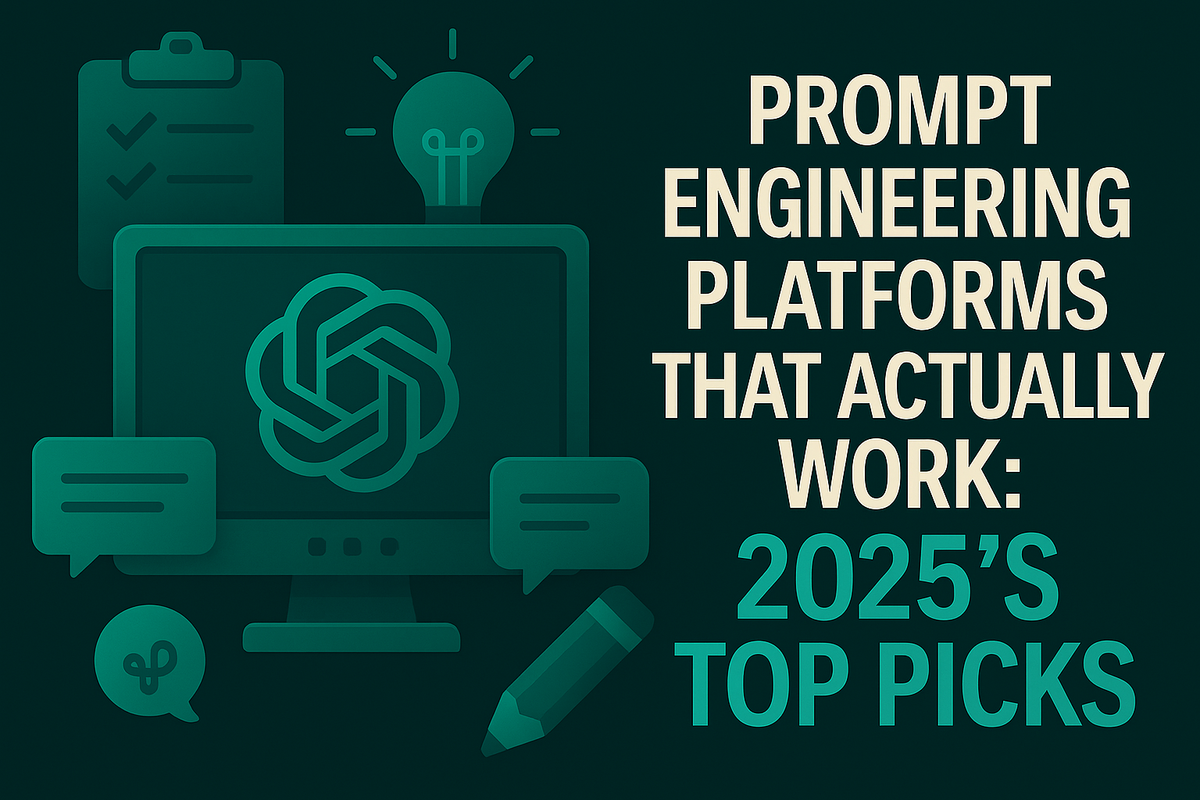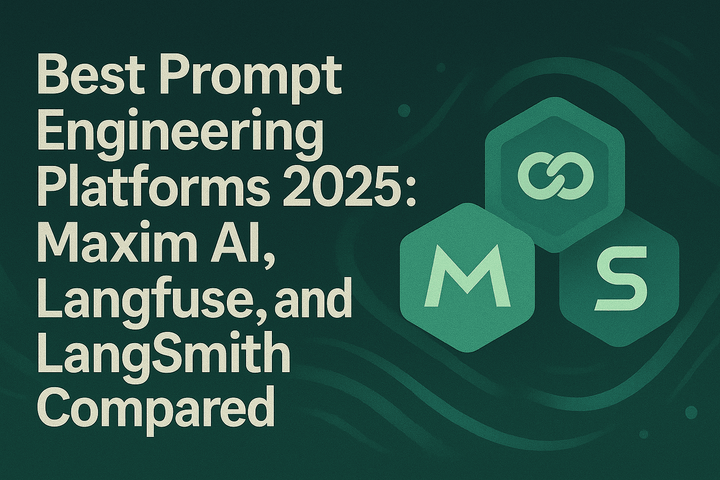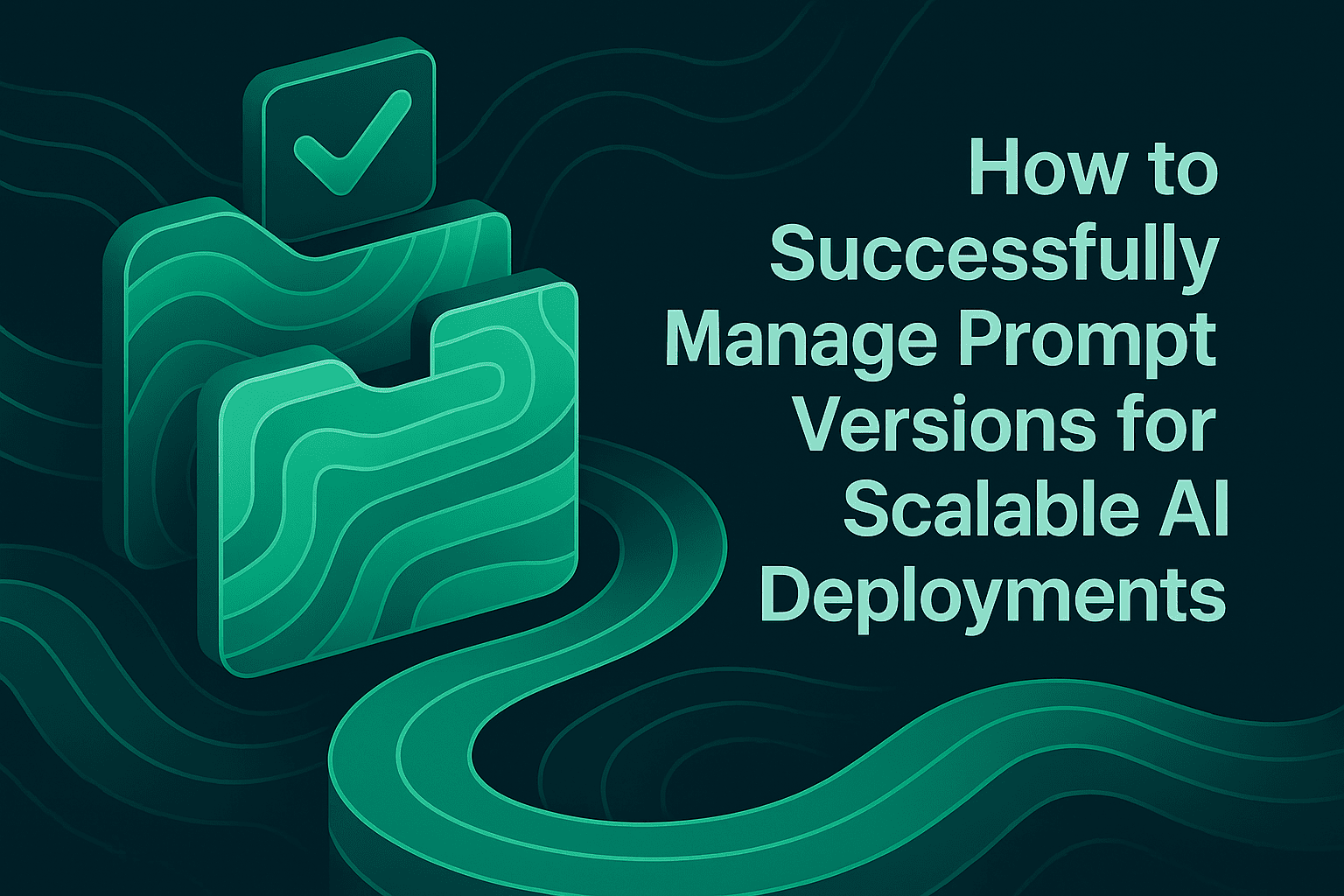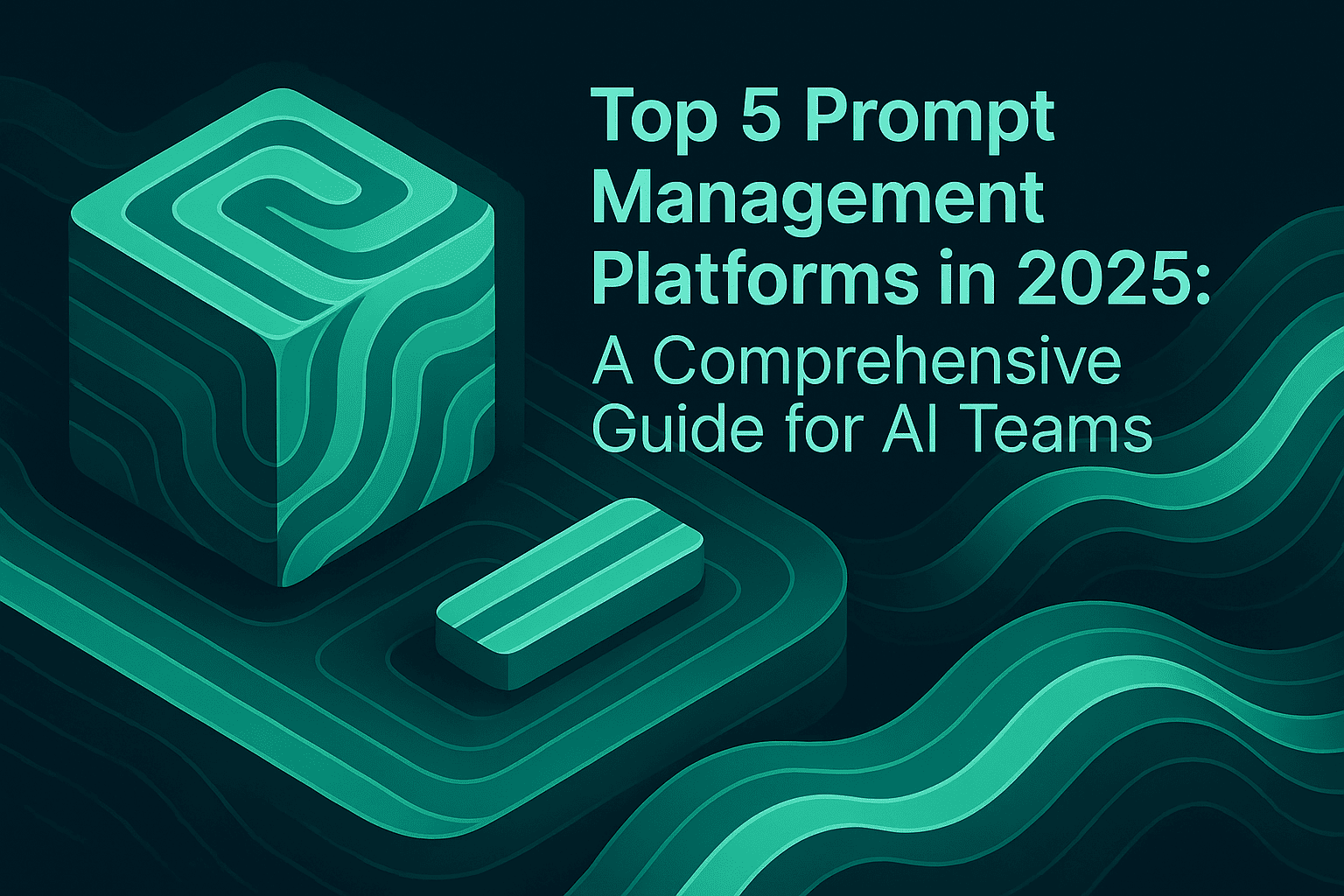Prompt Engineering Platforms That Actually Work: 2025’s Top Picks

In 2025 prompt engineering has become essential to ensure reliable performance of AI applications. If you pick the wrong platform, you waste time fixing errors instead of building new features.
1. Why Prompt Engineering Matters
1.1 From Playground to Production
In 2023, prompt engineering was often treated as an experimental technique- something teams used informally for quick tasks like debugging or content generation. By 2025, it has become core application infrastructure. Financial institutions now rely on AI systems to support lending decisions, healthcare organizations use retrieval-augmented generation pipelines to assist in clinical triage, and airlines process claims through automated agent workflows. In environments like these, a poorly constructed system prompt can introduce operational risk and lead to measurable financial consequences.
1.2 How Prompt Overload Disrupts Team Performance
A typical mid-market SaaS team now juggles:
- Customer-support agents localized in eight languages
- Marketing scribe agents that feed CMS pipelines
- Internal analytics pipelines for SQL generation
- Retrieval-Augmented Generation workflows used by knowledge-base search
- All of these depend on systematic prompt iteration supported by versioning, observability, and evaluations. Without version control, observability and automated evals, this becomes an unmaintainable mess.
1.3 Three External Pressures You Cannot Ignore
- Regulation: The EU AI Act, HIPAA, FINRA and a dozen sector-specific frameworks now require audit trails and bias monitoring for your AI applications.
- Cost Inflation: GPT-4o is twice as fast but also costly at scale. Bloated retrieval context can multiply your bills overnight as your token consumption surges. See “Top 8 AI Reliability Metrics Every Product Team Should Track in 2025.”
- User Trust: Hallucinated responses can break brand credibility and cause huge financial losses, as explored in “The State of AI Hallucinations in 2025.”
Bottom line: you need a platform that ensures your agents are reliable, you are able to debug and resolve most edge cases before your code is in production, you are able to iterate and experiment with multiple versions of your prompts, and you are able to work collaboratively across teams while decoupling prompts from your agent's code.
2. Six Features Every Platform Needs to Get Right
| Capability | Why It Matters | Red Flag If Missing |
|---|---|---|
| Version Control with Metadata | Roll back instantly, track who changed what, when and why | Only raw Git text diffs with no variable metadata |
| Automated Evals | Catch regression before prod, quantify accuracy, toxicity, bias, etc. | Manual spot-checks in spreadsheets |
| Live Observability | Trace request latency and token usage through OpenTelemetry instrumentation and Maxim’s monitoring interface. | Daily CSV export or sample logging |
| Multi-LLM & Gateway Support | Vendor neutrality, regional failover, cost arbitrage | Locked to a single model family |
| Role-Based Access & Audit Logs | Satisfy SOC 2, GDPR, HIPAA, internal security reviews | Shared API keys or per-user secrets in code |
| Native Agent & Tool-Calling Support | Enables testing of structured outputs, function calling, and multi-turn agent workflows. | Only single-shot text prompts |
3. Deep Dive: 2025’s Leading Platforms
3.1 Maxim AI Prompt Management
Best For: Teams that need an end-to-end platform covering a collaborative Prompt IDE, auto and human evals, agent simulation, and live observability.
Extra: Maxim provides Bifrost, a high-performance LLM gateway that supports more than 250 models across providers such as OpenAI, Anthropic, Bedrock, Vertex, Azure, and others, enabling model changes without modifying application code. A single virtual key can route traffic across multiple providers, including OpenAI, Anthropic, Bedrock, Vertex, Azure, and others, with built-in retry logic and automatic failover. Bifrost is approximately 50× faster than LiteLLM based on benchmark results.
How It Works
- Write or Import a Prompt in the Maxim UI or via CLI.
- Iterate over your Prompts to finetune agent performance
- Version your prompts and work collaboratively with your teams
- Run A/B Tests on your prompts
- Tag Your Prompts with team, locale, use-case and any custom metadata.
- Run Dataset-Driven Evals (accuracy, factuality, role compliance) on pull request. See “Top 5 AI Evaluation Tools in 2025” for comparing best evaluation tools.
- Simulate Agents which enable pre-deployment testing across diverse scenarios “Simulate Before You Ship.”
- Ship to Production through Bifrost, a high-performance gateway designed to maintain consistent throughput and reliability under load.
Strengths
- Integrated capabilities reduce the need to manage multiple separate tools.
- Tight integration with Maxim’s Observability, Evaluation and Simulation offerings.
- SOC 2 Type II, ISO 27001, in-VPC deployment option for enterprises.
3.2 PromptLayer
Best For: Solo devs or small teams who want Git-style diffs and a lightweight dashboard.
PromptLayer logs every prompt and completion, then displays side-by-side diffs. Evals and tagging arrived in 2024 but remain basic.
Pros
- Five-minute setup if you already call OpenAI directly.
- Generous free tier.
Cons
- No agent simulation.
- PromptLayer supports fewer providers, while Bifrost supports more than 250 models across major providers
- Observability limited to prompt-completion pairs, no step-level traces.
3.3 LangSmith
Best For: Builders who live inside LangChain and enjoy composable “chains” for complex workflows.
LangSmith records every chain step, offers dataset evals and a solid playground UI. If your stack is LangChain end-to-end, LangSmith feels natural.
Pros
- Step-level visualizer is useful for complex agent flows.
- Tight coupling with LangChain functions and templates.
Cons
- Locked to LangChain abstractions.
- Evals suite is still labeled beta.
- No gateway. You must manage API keys, retries and region routing yourself.
For more on LangChain agent debugging, read “Agent Tracing for Debugging Multi-Agent AI Systems.”
3.4 Humanloop
Best For: Teams that require heavy human-in-the-loop review, such as content moderation or policy drafting.
Humanloop highlights low-confidence outputs, queues them for human review and continuously fine-tunes prompts based on feedback.
Pros
- Active-learning loop helps reduce hallucinations quickly.
- UI focuses on reviewer productivity.
Cons
- Observability designed for batch jobs, not low-latency chat.
- No gateway or cost analytics.
- Pricing can spike when reviewer workloads explode.
3.5 Continue (Open Source)
Best For: Budget-conscious start-ups with DevOps muscle.
Continue is an OSS prompt library managed in YAML. Pair it with Grafana and OpenTelemetry and you can replicate some enterprise features.
Pros
- Zero license fees.
- Unlimited customization.
Cons
- DIY everything: RBAC, audit logs, eval hosting.
- Maintenance and upgrades are on you.
- No commercial SLAs.
4. Feature-by-Feature Comparison Table
| Feature | Maxim AI + Bifrost | PromptLayer | LangSmith | Humanloop | Continue (OSS) |
|---|---|---|---|---|---|
| Versioning & Audit | ✔ Granular diff with metadata | ✔ Git-style | ✔ Chain diff | ✔ Review logs | YAML only |
| Automated Evals | ✔ Dataset + custom metrics | ✔ Basic | 🔶 Beta | 🔶 Limited | ❌ DIY |
| Agent Simulation | ✔ Multi-turn, tool calling | ❌ | 🔶 Chain tests | ❌ | ❌ |
| Live Observability | ✔ Span-level, token cost | ✔ Prompt pair | ✔ Chain step | 🔶 Batch focus | ❌ |
| Gateway Routing | ✔ Multi-provider routing with adaptive load balancing and automatic failover. | ❌ | ❌ | ❌ | ❌ |
| SOC 2 / ISO 27001 | ✔ | 🔶 Partial | 🔶 | 🔶 | ❌ |
| Free Tier | 1M tokens | 200k tokens | Dev seat $20 | Seat $29 | Free |
Legend: ✔ native, 🔶 partial, ❌ missing
5. Compliance and Security Checklist
| Control | Why You Care | Maxim AI |
|---|---|---|
| RBAC & SSO | Prevent prompt tampering by interns | ✅ |
| Audit Logs | Required for SOC 2, GDPR Article 30 | ✅ |
| Data Residency | EU and US buckets | ✅ |
| Key Management | Bring-your-own KMS | ✅ |
If a vendor cannot share an up-to-date pen-test summary, walk away.
6. Cost Models and ROI Math
6.1 Token Economics
A single problematic prompt that causes your agent to make 2k-token context retrievals via tool calls, five times per interaction, can add $10k a month to your bill. Observability makes that visible and with proper Prompt Engineering you can solve it to make targeted tool calling and save on wasteful expenditure.
6.2 Human Review Costs
Platforms with poor auto evals often require large human QA teams. Assume $25 per hour for reviewers. Compute that with the number of outputs your application generates per day and see how fast that balloons up.
6.3 Vendor Lock-In Tax
Switching from GPT-4o to Claude 3 for cost or latency gains can save up to 35 percent. Only gateways like Bifrost make that a one-line config change.
7. Final Recommendations on Prompt Management
Ensure your prompts are versioned, labeled with clear tags, and stored in a systematic manner. Collaborate effectively across product and tech teams to build optimised prompts for your AI applications with a super intuitive prompt playground.
Experiment with prompts, iterate and test across models and prompts, manage your experiments, and deploy with confidence
To see how a standardized approach to prompt engineering works in practice, schedule a Maxim demo.
8. Further Reading
Internal Maxim Picks:
- LLM Observability: How to Monitor Large Language Models in Production
- Why Monitoring AI Models Is Key to Reliable and Responsible AI
- Top 5 Tools to Detect Hallucinations in AI Applications
- How to Ensure Reliability of AI Applications
- Prompt Management in 2025: How to Organize, Test, and Optimize Your AI Prompts
External Must-Reads:


